As an Amazon Associate I earn from qualifying purchases. Please read the disclaimer for more info.
Spices are integral to Asian cuisine and are vital in adding flavor, aroma, and color to the region’s many delicious dishes. There are at least 21 Asian spices that are essential to any Asian recipe.
With diverse ingredients and unique combinations, Asian cooking has long been recognized for its rich and varied flavors. From earthy and woody to tangy and spicy, we will explore the unique characteristics of each spice and how it enhances the dish’s overall taste.
Throughout Asia, spices such as turmeric, cumin, and coriander are commonly used to add layers of depth to curries and stir-fries. In contrast, spices like clove and star anise are often used in slow-cooked dishes, imparting a sweet and subtle flavor.
Moreover, spices such as ginger, garlic, and chili peppers are considered the building blocks of Asian cuisine. These oriental spices add heat and pungency to the dish and are touted for their medicinal properties.
Whether you are a seasoned home cook or a novice looking to explore the vast world of Asian cooking, this blog post will surely provide valuable insights into the top 15 Asian spices you need to know.
Related: The Spices of Zanzibar
List of Asian Spices and Seasonings to Spice up Your Kitchen
Star Anise
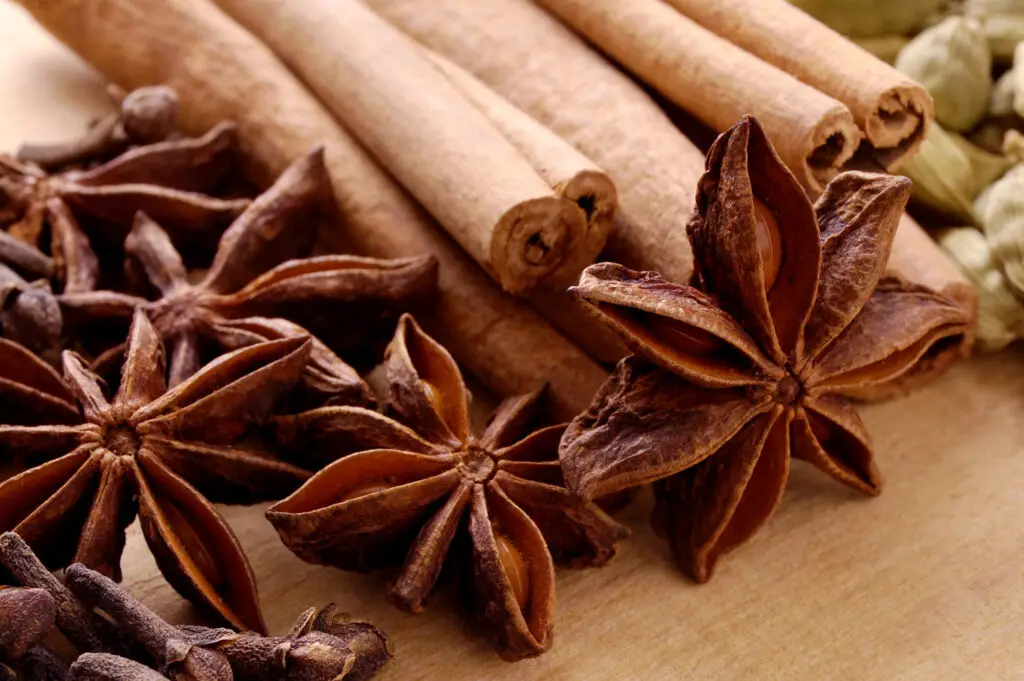
Star anise is a fragrant and unique spice commonly used in Asian cuisine. Its distinct star shape, deep brown color, and licorice-like taste make it a favorite among chefs and food enthusiasts.
In Asian cooking, star anise is often used to flavor soups, stews, and broths, adding a warm and complex depth of flavor.
It is also essential in traditional five-spice powder, a blend of spices commonly used in Chinese cuisine.
In addition to its culinary uses, star anise is believed to have medicinal properties. It has been used in traditional Chinese medicine for centuries to alleviate digestive issues and promote overall wellness.
Related: Food Travel: My Top 10 Tips for Planning a Food Trip
Ginger
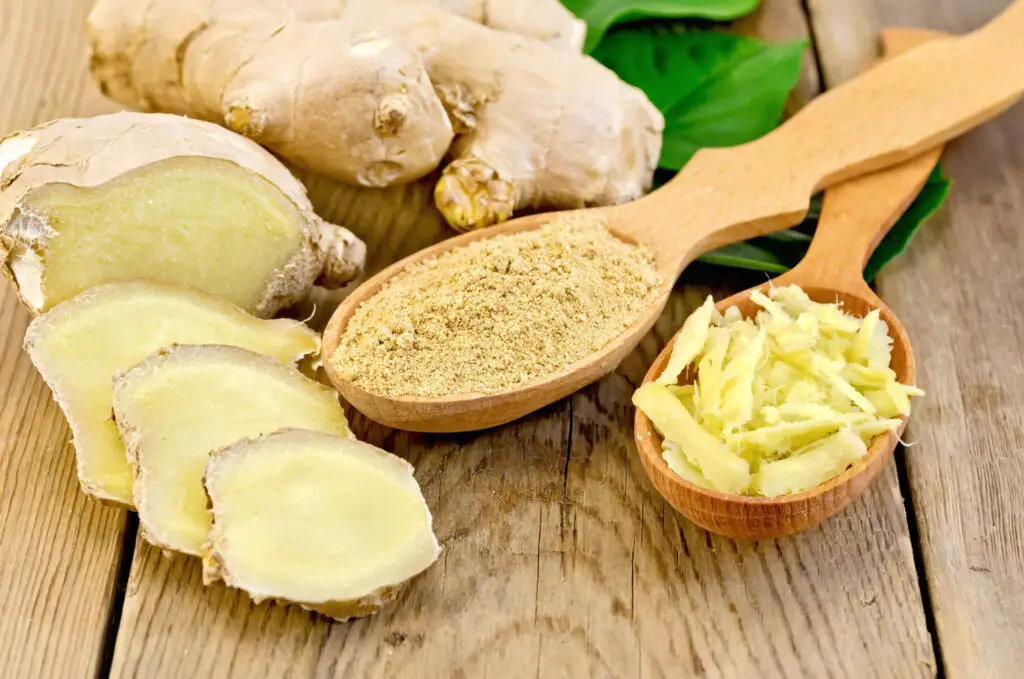
Ginger powder is a popular oriental spice used in Asian cooking, known for its unique flavor and aroma.
Commonly referred to as ground ginger or powdered ginger, it is made by drying fresh ginger root and grinding it into a fine powder.
Its versatility makes it a staple ingredient in many dishes, from savory curries to sweet desserts.
It adds a distinct zing to soups and stews, enhancing the stir-fries and marinades’ flavor.
Related: Vietnamese Spices: Discover the Secret Ingredients
Fennel Seeds
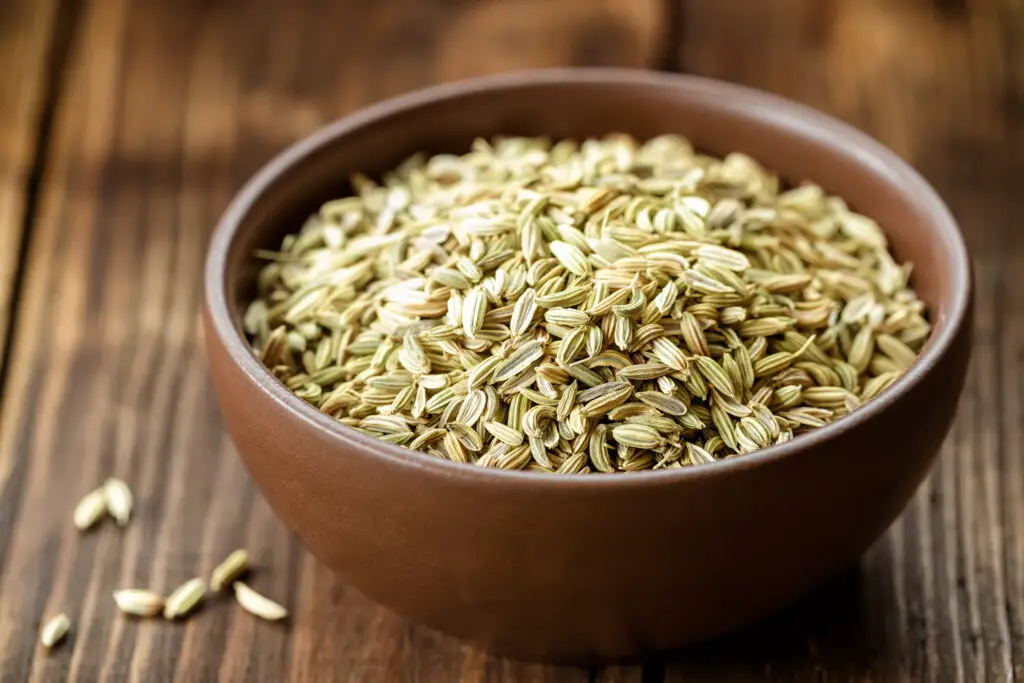
Fennel seeds are more than just a spice found in Italian cuisine. In fact, they are widely used in Asian cooking as well, adding a unique flavor and aroma to dishes.
These tiny seeds are commonly used in Pakistani and Indian cooking, where they are often roasted and ground to make masala blends or used to flavor rice dishes.
In Chinese cuisine, fennel seeds are used in soups, marinades, and rubs for roasted meats. They also appear in Korean cuisine, where they are used to flavor pickled vegetables.
Coriander seeds

Coriander seeds are a staple in Asian cooking, used to add flavor and depth to various dishes. These small, round seeds have a pungent, citrusy flavor that pairs well with spicy and savory foods.
In Indian cuisine, coriander seeds are often toasted and ground into a powder to make garam masala, a spice blend used in curries, soups, and stews.
In Thai cuisine, coriander seeds are a key ingredient in green curry paste, adding a subtle warmth and depth of flavor to the dish.
Further Reading: Penang Tropical Spice Garden
Black Peppercorns

Black peppercorns are no stranger to Asian cuisine. Used as a staple spice in almost every kitchen, these small, round, dried berries are known for their distinct flavor and aroma.
As to how they make their way into dishes, they can be crushed, ground, or used whole and are often added early in the cooking process to release their bold flavor.
In Asian cooking, black peppercorns are frequently used to create unique and flavorful spice blends, such as five-spice powder.
White Peppercorns

White peppercorns are one of the most popular spices used in Asian cooking. They are known for being bold in flavor and are often added to dishes for a slightly spicy kick.
Unlike their black counterparts, white peppercorns have been soaked, and their outer coatings removed.
This process gives the peppercorns a distinct flavor and aroma, perfect for many dishes, including soups, stir-fries, and marinades.
Garam Masala

Garam masala is an aromatic blend of Asian spices widely used in the region’s cuisine. It is primarily made up of cinnamon, cumin, coriander, cardamom, cloves, and black pepper, but can also include other spices depending on the recipe.
This warm and pungent spice mix is essential in many traditional dishes, like curries, chutneys, and biryanis.
It is believed that garam masala was originally created in Northern India and Pakistan, but it has since spread across the globe and is now enjoyed in many different cuisines.
Sesame Seeds (White Sesame Seeds and Black Sesame Seeds)

Sesame seeds have been a staple ingredient in Asian cuisine for centuries. These small, flavorful seeds are used as a spice in various dishes, imparting a nutty and toasted flavor.
They are commonly found in Japanese, Korean, Chinese, and Vietnamese cuisine and are used for savory and sweet dishes.
One popular use of sesame seeds is as a topping for sushi rolls, adding a crunch and flavor to the dish.
They are also used to make sauces, such as the famously nutty and rich sesame sauce for cold noodles in Chinese cuisine.
In Korean cuisine, sesame seeds are used as a marinade for meat dishes, and in Japan, they are used in a condiment called gomashio.
Despite their small size, sesame seeds play a big role in adding complexity and depth to Asian dishes.
Related: 10 Substitutes for Sesame Seeds for that Nutty Flavor
Chinese Five-Spice Powder

For centuries, five spice powder has been an essential spice used in Asian cooking. This unique blend of Asian spices comprises cinnamon, cloves, fennel seeds, star anise, and Sichuan peppercorns.
With its bold and complex spicy flavor profile, five-spice powder is often used to add depth to meat dishes such as roasted duck or pork belly.
Additionally, it can be used in sauces and marinades or sprinkled on vegetables and tofu for added flavor.
Turmeric

Turmeric is an Asian spice commonly used in cooking that provides a distinct taste, aroma, and color to dishes.
It is derived from the root of the Curcuma longa plant and has been used for centuries in traditional medicine and culinary practices.
The bright yellow-orange color adds a beautiful hue to food, making it a staple in curries and rice dishes.
Besides its culinary purposes, turmeric is also known for its anti-inflammatory properties, making it a popular supplement in health and wellness circles.
Mustard Seeds

Mustard seeds are a staple spice in many Asian kitchens, adding an earthy, pungent flavor to dishes ranging from curries to pickles.
These tiny seeds come in two varieties: yellow and brown. Yellow seeds are milder and often used in more delicate dishes, while brown seeds pack a stronger punch and are often used in spicier dishes.
Mustard seeds are often toasted or fried before use to release their full flavor potential. Additionally, they are often tempered in hot oil with other spices before being added to a dish, which helps to release their aromatic compounds.
Curry Powder
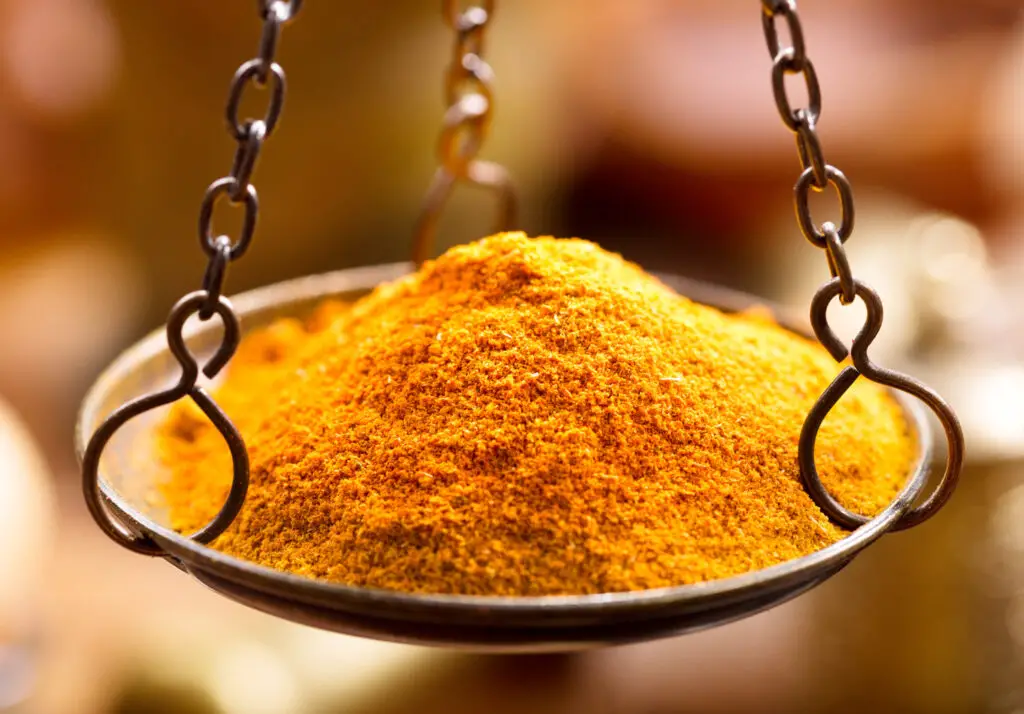
With its vibrant colors and intense flavors, Asian cuisine is renowned for its bold culinary experience.
The quintessential spice mix called curry powder is at the heart of many dishes. This aromatic blend of various herbs and spices adds a unique warmth and depth of flavor to any dish used in.
From classic Indian curries to stir-fries and soups, curry powder is a staple in Asian cooking. Its pungent taste and tangy aroma enhance the complexity of flavors and make any meal a sensory explosion.
Whether you prefer a milder or spicier version, there is something for everyone in the world of curry powder. Try it on veggies, rice, or meat, and take your taste buds on an exotic culinary adventure.
Cinnamon

Cinnamon, a spice loved for its unmistakable aroma and warm, sweet taste, is a staple in Asian cuisine.
While it is famously used in sweet dishes like cinnamon rolls and apple pie, cinnamon is equally popular in savory Asian dishes.
It is used in curries, rice dishes, and tea in India. In China, it is used in five-spice powder and as a seasoning for meats.
Cinnamon is also popular in Indonesian and Malaysian cuisine, where it is used in spice pastes for meat and seafood.
Its versatility has made cinnamon one of the go-to Asian spices in Asian kitchens, adding depth, warmth, and complexity to any dish.
Fenugreek

Fenugreek, an herb widely used in Asian cuisine, has a distinct flavor and aroma that adds depth and complexity to dishes.
Known for its slightly bitter taste with a hint of sweetness, this Asian spice is a key ingredient in curries, stews, and chutneys.
Fenugreek seeds are commonly used in Indian and Pakistani cuisine as a flavoring agent, while its leaves are commonly used in Ethiopian cuisine.
Its versatility makes it an essential ingredient in many dishes, whether used as a seasoning, a vegetable, or added to sauces and condiments.
Cloves

Cloves are a beloved spice in Asian cuisine, known for their warm, sweet, and slightly bitter flavor.
Originating from the Maluku Islands in Indonesia, cloves have entered kitchens across Asia due to their versatility. They are commonly used in curries, marinades, and spice blends, such as garam masala, in Indian cuisine.
In Chinese cooking, cloves are often used in savory dishes such as five-spice powder and red-cooked meats.
Besides adding flavor to dishes, cloves are also recognized for their medicinal properties, such as improving digestion and reducing inflammation.
Galangal

Galangal is a spice used in Asian cuisine for centuries to add a unique flavor and aroma. Also known as Thai ginger, this root Oriental spice is native to Southeast Asia and is a member of the ginger family.
Galangal has a distinct lemony, earthy, spicy, sweet flavor.
It is often used in Vietnamese and Thai dishes such as soups like Tom Kha Gai, a coconut milk-based soup with chicken and vegetables, and the traditional Vietnamese Pho.
Galangal is another one of the Asian spices that is a versatile ingredient that adds depth and complexity to any dish, making it a must-have in any spice rack or pantry.
Further Reading: 5 Substitutes for Galangal to Spice Up Your Recipe
Seven Spice

Seven Spice is a unique blend of spices used in Asian cuisine for centuries. This aromatic mixture typically consists of cinnamon, fennel, cloves, star anise, Sichuan pepper, ginger, and nutmeg.
These Asian spices are ground together to create a mouthwatering combination that adds depth, complexity, and a touch of warmth to savory dishes.
Seven spice is commonly used in meat marinades, stir-fries, soups, and stews but can also be sprinkled over roasted vegetables or tofu for added flavor.
Its versatile flavor makes it a great addition to any dish, and its pungent aroma will awaken your senses.
Szechuan Peppercorns

Szechuan peppercorns have been a beloved spice in Asian cuisine for centuries. Unlike other peppercorns, they have a distinctive numbing effect on the tongue, creating a unique sensory experience.
They are commonly used in dishes such as Kung Pao chicken and Mapo tofu, adding heat and floral notes.
Despite the name, Szechuan peppercorns are not actually related to black pepper, instead coming from the dried fruit husks of the prickly ash plant.
Garlic Powder

Often considered a staple in many Asian cuisines, garlic powder is a versatile spice that adds a distinct flavor to dishes.
Made from finely ground dehydrated garlic, the powder version is an easy way to incorporate the pungent taste of garlic into any meal without the hassle of peeling and chopping.
In Asian cooking, garlic powder is a key ingredient in many dishes, such as stir-fries, curries, and soups.
Its use in these dishes adds depth and aroma to the dish and enhances the overall flavor profile.
Cumin

Cumin, known for its warm and earthy flavor, is an integral spice in the world of Asian cooking. Hailing from the parsley family, this spice is a powerhouse of nutrition and has been used in cooking for hundreds of years.
In Asian cuisine, cumin is a staple spice to add depth and enhance flavors in dishes such as curries, stir-fry, vegetable dishes, and even soups.
This versatile spice adds a lovely aroma and is popularly paired with other spices like coriander, turmeric, and chili peppers.
Its robust and complex flavor profile makes cumin an indispensable ingredient for anyone looking to add a touch of sophistication to their Asian-inspired cooking.
Chili
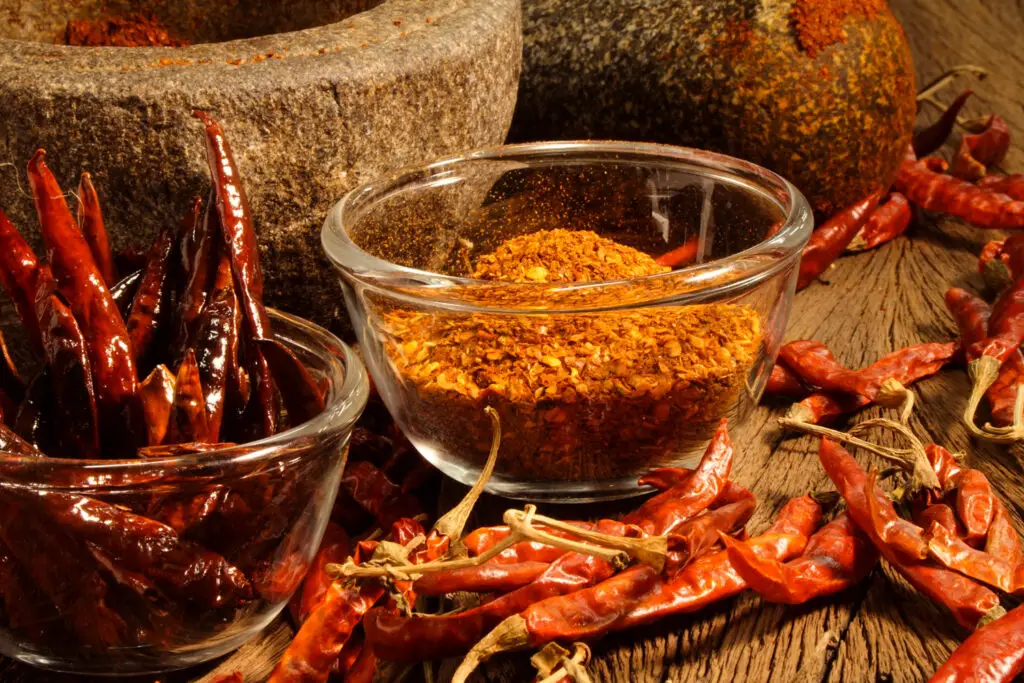
Chili, also known as chili pepper or red pepper, is an incredibly versatile spice in many Asian dishes.
Its heat is often balanced with other ingredients, such as garlic, ginger, lemongrass, or coconut milk, allowing for a complex interplay of flavors.
In Thai cooking, fresh bird’s eye chili is commonly used to add heat to curries, stir-fries, and soups, while dried chili flakes are a staple in Korean cuisine, offering a fiery kick to bibimbap, ramyun, and kimchi.
Chili oil is drizzled in Chinese dishes over dumplings, noodles, and tofu. At the same time, Sichuan cuisine takes the heat to a whole new level with its signature mala hot pot, numbing and spicy food simultaneously.
Summary of Asian Spices in Asian Dishes
It is amazing how vital Asian spices are to the continent’s cuisine. They have an extraordinary ability to bring out the unique, tantalizing flavors that make this food special. Spices such as ginger, turmeric, and cilantro add an incredible depth of flavor that elevates any dish. With the right combination of fragrant oriental spices and ingredients, you can recreate a tasty dish from Asia in your own kitchen!
Further Reading:

